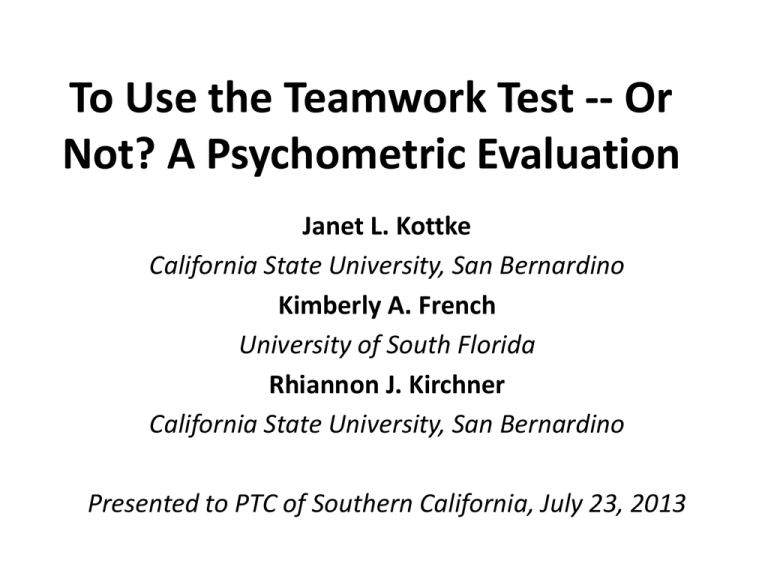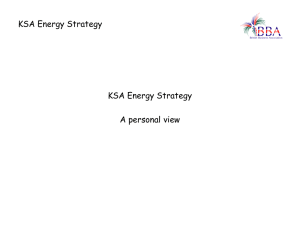To Use the Teamwork Test - Personnel Testing Council of Southern
advertisement

To Use the Teamwork Test -- Or Not? A Psychometric Evaluation Janet L. Kottke California State University, San Bernardino Kimberly A. French University of South Florida Rhiannon J. Kirchner California State University, San Bernardino Presented to PTC of Southern California, July 23, 2013 TKSA Development • Stevens and Campion (1994; 1999) develop the Teamwork KSA Test – 35 items, multiple choice format (4 options, dichotomous scoring) • Reviewed teamwork literature – Identified 14 KSAs identified with effective teamwork Kottke, French, & Kirchner PTC July 23, 2013 2 14 KSAs → 5 facets • These 14 KSAs represent – Five facets • • • • • Conflict resolution Collaborative problem solving Communication Goal setting and performance management Planning and task coordination Kottke, French, & Kirchner PTC July 23, 2013 3 5 facets → 2 dimensions • Two higher-order dimensions: – Interpersonal KSAs • Conflict resolution • Collaborative problem solving • Communication – Self-management KSAs • Goal setting and performance management • Planning and task coordination Kottke, French, & Kirchner PTC July 23, 2013 4 Teamwork KSA Structure O’Neill, Goffin, & Gellatly, 2012, p. 37 Kottke, French, & Kirchner PTC July 23, 2013 5 Knowledge, Skill, and Ability (KSA) Requirements for Teamwork I. INTERPERSONAL KSAs A. Conflict Resolution KSAs 1. The KSA to recognize and encourage desirable, but discourage undesirable, team conflict. 2. The KSA to recognize the type and source of conflict confronting the team and to implement an appropriate conflict resolution strategy. 3. The KSA to employ an integrative (win-win) negotiation strategy rather than the traditional distributive (win-lose) strategy. B. Collaborative Problem Solving KSAs 4. The KSA to identify situations requiring participative group problem solving and to utilize the proper degree and type of participation. 5. The KSA to recognize the obstacles to collaborative group problem solving and implement appropriate corrective actions. C. Communication KSAs 6. The KSA to understand communication networks, and to utilize decentralized networks to enhance communication where possible 7. The KSA to communicate openly and supportively, that is, to send messages which are: (1) behavior- or event-oriented; (2) congruent; (3) validating; (4) conjunctive; and (5) owned. 8. The KSA to listen nonevaluatively and to appropriately use active listening techniques. 9. The KSA to maximize consonance between nonverbal and verbal messages, and to recognize and interpret the nonverbal messages of others. 10. The KSA to engage in ritual greetings and small talk, and a recognition of their importance. II. SELF-MANAGEMENT KSAs D. Goal Setting and Performance Management KSAs 11. The KSA to help establish specific, challenging, and accepted team goals. 12. The KSA to monitor, evaluate, and provide feedback on both overall team performance and individual team member performance. E. Planning and Task Coordination KSAs 13. The KSA to coordinate and synchronize activities, information, and task interdependencies between team members. 14. The KSA to help establish task and role expectations of individual team members, and to ensure proper balancing of workload in the team. (Adapted from Steven & Campion, 1994, Table One, p. 505) 6 Sample Question • When you set work goals for yourself or your work team, what are the best goals to set? A. Set goals to "do your best." B. Set general and broad goals. C. Set specific and detailed goals. D. Set easy and simple goals. Kottke, French, & Kirchner PTC July 23, 2013 7 Criterion validity • Several studies have found predictability of supervisor and observer ratings of team effectiveness (rs range .20 to .56) – Ellis, Bell, Ployhart, Hollenbeck, & Ilgen, 2005 – Leach, Wall, Rogelberg, & Jackson, 2005 – McClough & Rogelberg, 2003 – Morgeson, Reider, & Campion, 2005 • Mixed results in predicting team member peer ratings Kottke, French, & Kirchner PTC July 23, 2013 8 Questions about predictive validity • Miller, 2001 – Issues raised about Stevens & Campion validation studies • Team performance was predicted less well (r = .44) than task work (r = .56) • TKSA predicted team performance only slightly better than did an aptitude test – But: TKSA added incremental variance beyond GMA • Aptitude data suggest individual aptitude, not teamwork aptitude measured – Miller’s own study finds no significant relationship between team performance and TKSA scores Kottke, French, & Kirchner PTC July 23, 2013 9 Questions about psychometrics • O’Neill, Goffin, & Gellatly (2012) examine the TKSA – Comprehensive analysis • • • • • • Reviewed all known studies using TKSA Classic test theory analysis Confirmatory factor analysis Exploratory factor analysis Convergent, discriminant validation Criterion validity analysis – Disappointing results all around Kottke, French, & Kirchner PTC July 23, 2013 10 Our plan • Replicate O’Neill CTT & CFA analyses with fresh samples • Data sources – Had used the TKSA Test for a group project in several classes (sample 1) – Collected new data to address unexpected finding from sample 1 that aptitude was negatively related to teamwork interest (sample 2) – Collected data for a thesis project on teamwork and task interdependence (sample 3) Kottke, French, & Kirchner PTC July 23, 2013 11 The 3 samples • Students from a mid-size southwestern University. – Sample 1 = 251 college students • Cohort groups, upper level undergraduate-level psychology course, term-length group project. – Sample 2 = 279 college students • Recruited from psychology and business courses – Sample 3 = 404 college students • From upper-level undergraduate courses in both psychology and business departments, either a long-term (i.e., several weeks) or term-length group project Kottke, French, & Kirchner PTC July 23, 2013 12 Work experience of samples • Although students, vast majority were employed – 96% in sample 1 – 82.4% in sample 2 – 88.4% in sample 3 • Work experience ranged from means of 5.5 to 7.3 years – SDs ranged from 5.6 to 6.3 years Kottke, French, & Kirchner PTC July 23, 2013 13 Table 1. Demographic Descriptive Statistics Sample 1 M SD 25.1 6.6 7.3 5.9 - Sample 2 M SD 23.1 7.0 5.5 6.3 1.8 2.0 4.4 11.9 Sample 3 M SD 23.9 6.1 5.9 5.6 - Gender (% Female) Ethnicity African American Asian American Hispanic 82.1% 74.9% 65.1% 9.2% 4.4% 45.4% 11.5% 4.7 % 47.3% 8.2% 4.5% 45.0% White Other Education Freshman Sophomore Junior Senior Graduate Other Respondents with work experience Respondents with supervisor experience 35.1% 6.0% 26.9% 8.2% 29.7% 11.9% 0.4% 2.8% 43.4% 51.0% 2.0% 16.5% 14.3% 33.3% 34.1% 0.4% 0.0% 4.7% 50.2% 42.6% 0.2% 0.4% 96.0% 40.2% 0.4% 82.4% 24.7% 0.5%% 88.4% - Demographic Characteristic Age Work experience (years) Number of term-length group projects Number of work group projects Kottke, French, & Kirchner PTC July 23, 2013 14 Analyses conducted • Analytic Approach – In each sample we evaluated • Classical test theory – Item, subscale, and total measure properties, » Means, standard deviations, and item-total correlations – Subscale and total measure means, standard deviations, and internal reliability • Structure using categorical confirmatory factor analysis (Mplus) – One factor model, two factor model, and a five factor model » For multi-factor models, both a covaried model (all factors were allowed to correlate), as well as a higher-order model (includes higher-order general teamwork KSA factor) Kottke, French, & Kirchner PTC July 23, 2013 15 Supplemental • Supplemental analysis – To ensure psychometric issues are not a result of student samples, ran classical test analyses on the subset of working respondents from each sample. – Results from working samples were not substantially different than full samples • For example, average absolute difference in factor and total means was .11 for sample 1 [SD = .07], .21 for sample 2 [SD = .19], and .14 for sample 3 [SD = .21]. • The average difference in inter-item correlations was .02 [SD = .01]) • Thus, only the results from the full samples are presented here. Kottke, French, & Kirchner PTC July 23, 2013 16 RESULTS: Item means, SDs, item total correlations Table 2. Teamwork KSA Test item-level means, standard deviations, and item-total correlations for all samples. Sample 1 Subscale Item Statistics M(p) Conflict resolution mean Conflict resolution SD Communication mean Communication SD Collaborative problem solving mean Collaborative problem solving SD Goal setting & performance management mean Goal setting & performance management SD Planning and task coordination mean Planning and task coordination SD Grand mean Grand SD 0.69 0.16 0.54 0.13 0.42 0.14 0.60 0.12 0.64 0.10 0.55 0.16 Sample 2 SD ri-f ri-h ri-t 0.43 0.07 0.48 0.02 0.47 0.02 0.47 0.04 0.47 0.03 0.47 0.04 0.14 0.09 0.13 0.06 0.13 0.09 0.20 0.07 0.15 0.02 0.14 0.08 0.22 0.14 0.17 0.06 0.18 0.16 0.22 0.04 0.18 0.02 0.19 0.10 0.26 0.15 0.17 0.07 0.20 0.17 0.23 0.05 0.24 0.07 0.21 0.12 M(p) 0.64 0.19 0.54 0.13 0.42 0.13 0.58 0.12 0.63 0.12 0.54 0.15 Sample 3 SD ri-f ri-h ri-t 0.45 0.06 0.48 0.02 0.48 0.02 0.48 0.01 0.47 0.03 0.48 0.03 0.08 0.05 0.08 0.09 0.14 0.09 0.07 0.07 0.13 0.05 0.10 0.08 0.22 0.11 0.13 0.11 0.16 0.10 0.13 0.07 0.17 0.09 0.15 0.10 0.17 0.14 0.15 0.11 0.18 0.10 0.19 0.05 0.23 0.09 0.17 0.10 M(p) 0.67 0.20 0.53 0.15 0.40 0.13 0.59 0.11 0.64 0.13 0.54 0.16 SD ri-f ri-h ri-t 0.44 0.07 0.48 0.02 0.47 0.02 0.48 0.01 0.47 0.04 0.47 0.03 0.05 0.05 0.11 0.07 0.11 0.09 0.19 0.06 0.15 0.03 0.12 0.07 0.16 0.11 0.14 0.08 0.14 0.08 0.25 0.02 0.22 0.02 0.17 0.08 0.17 0.12 0.16 0.07 0.16 0.09 0.28 0.02 0.24 0.05 0.19 0.08 Notes. M(p) = item means, SD = item standard deviations, ri-f = corrected item-factor correlation,, ri-h = corrected item-higher order factor correlation, ri-t = corrected item-total correlation. Kottke, French, & Kirchner PTC July 23, 2013 17 More Results: Scale means, SDs, inter item correlation means, KR 20s Table 3. Teamwork KSA Test facet and total means, standard deviations, reliability, and item correlation summary for all samples Sample 1 Sample 2 Inter-item correlation Sample 3 Inter-item correlation Inter-item correlation Teamwork KSA Test Score No. of Items M SD K-R 20 M Range M SD K-R 20 M Range M SD K-R 20 M Range Interpersonal KSAs Conflict Resolution Communication Collaborative Problem Solving Self-Management KSAs Goal Setting & Performance Management 25 4 12 13.05 2.75 6.49 3.55 .97 2.04 .58 .25 .36 .06 .09 .05 -.12, .32 -.06, .26 -.11, .26 12.84 2.55 6.53 3.36 .95 1.89 .52 .15 .24 .05 .05 .03 -.17, .23 -.01, .14 -.10, .22 12.72 2.67 6.41 3.29 .91 1.99 .51 .10 .33 .04 .03 .04 -.15, .19 -.11, .16 -.11, .19 9 10 3.82 6.23 1.71 1.99 .34 .49 .05 .09 -.12, .23 .00, .27 3.76 6.06 1.72 1.87 .35 .39 .06 .06 -.08, .22 -.08, .22 3.63 6.11 1.64 2.10 .28 .54 .04 .11 -.07, .18 -.01, .26 5 3.01 1.29 .40 .12 .04, .24 2.90 1.16 .17 .03 -.06, .14 2.93 1.29 .38 .11 .03, .23 5 35 3.22 19.29 1.20 4.84 .30 .69 .08 .06 .00, .18 -.14, .32 3.17 18.81 1.19 4.69 .27 .65 .07 .05 -.05, .22 -.17, .25 3.19 18.82 1.21 4.70 .32 .67 .09 .05 -.01, .26 -.15, .26 Planning & Task Coordination Teamwork KSA Overall Kottke, French, & Kirchner PTC July 23, 2013 18 Confirmatory Factor Analysis Results on following slide Kottke, French, & Kirchner PTC July 23, 2013 19 Table 4. Summary of confirmatory factor analysis results Sample Sample 1 Model Five factor, covariedb Revised five factor, covarieda 2 198.12* df 158 CFI .85 RMSEA .032 Absolute Loading Mean .34 309.23** 152 .41 .064 .41 Five factor, higher order Revised five factor, higher 359.39** 154 .24 .072 .44 -.03 to 1.00 202.701* 159 .84 .033 .34 -.51 to .82 202.95* 156 .36 .066 .36 -.09 to 1.00 202.701* 159 .84 .033 .34 -.10 to .82 211.12 183 .88 .022 .29 -.08 to .58 308.61** 182 .47 .048 .38 -.09 to .71 Two factor, higher order Did not converge Revised two factor, higher ordera Single factor Five factor, covariedb Revised five factor, covarieda Five factor, higher order Revised five factor, higher Did not converge ordera Two factor, covaried 368.40** 182 .22 .058 .38 -.09 to 1.00 212.79 184 .88 .023 .30 -.49 to.62 Two factor, higher order Revised two factor, higher Did not converge ordera Single factor Sample 3 Five factor, covariedb Revised five factor, covarieda 363.73** 182 .24 .057 .32 -.08 to 1.00 212.54 184 .88 .022 .30 -.08 to .62 327.42** 213 .78 .036 .33 -.01 to .61 471.13** 211 .51 .055 .40 .01 to .71 Five factor, higher order Did not converge Revised five factor, higher ordera Two factor, covaried 565.28** 209 .32 .065 .40 .01 to 1.00 345.70** 214 .75 .039 .32 -.55 to .52 Two factor, higher order Revised two factor, higher Single factor -.05 to .92 Did not converge ordera Two factor, covaried Sample 2 Loading Range -.10 to .83 Did not converge ordera 527.38** 211 .40 .061 .32 .03 to 1.00 353.40** 214 .74 .040 .30 -.01 to .52 *p < .01, **p < .001 Kottke, French, & Kirchner PTC July 23, 2013 20 Discussion • To be fair to the test authors – They recommend the subscales be used for training and developmental purposes only – In all of their publications, they use only total scores – So, whether the test authors intended a hierarchical structure is not a certainty • Yet, with their careful development that categorized the 14 KSAs into specific facets, one would expect meaningful structure • Criterion validity has been found, but issues here as well – TKSA test correlates highly with general mental ability – Some incremental predictability Kottke, French, & Kirchner PTC July 23, 2013 21 Conclusion • Very limited evidence for adequate psychometric properties • Use with caution – Recognize the test’s limitations Kottke, French, & Kirchner PTC July 23, 2013 22 Thank you Kottke, French, & Kirchner PTC July 23, 2013 23 Questions? Kottke, French, & Kirchner PTC July 23, 2013 24 References Ellis, A. J., Bell, B. S., Ployhart, R. E., Hollenbeck, J. R., & Ilgen, D. R. (2005). An evaluation of generic teamwork skills training with action teams: Effects on cognitive and skillbased outcomes. Personnel Psychology, 58, 641-672. Leach, D. J., Wall, T. D., Rogelberg, S. G., & Jackson, P. R. (2005). Team autonomy, performance, and member job strain: Uncovering the teamwork KSA link. Applied Psychology: An International Review, 54, 1-24. McClough, A. C., & Rogelberg, S. G. (2003). Selection in teams: An exploration of the Teamwork Knowledge, Skills, and Ability test. International Journal of Selection and Assessment, 11, 56-66. Miller, D. L. (2001). Reexamining teamwork KSAs and team performance. Small Group Research, 32(6), 745. Morgeson, F. P., Reider, M. H. & Campion, M. A. (2005). Selecting individuals in team settings: The importance of social skills, personality characteristics, and teamwork knowledge. Personnel Psychology, 58, 583-611. O'Neill, T. A., Goffin, R. D., & Gellatly, I. R. (2012). The knowledge, skill, and ability requirements for teamwork: Revisiting the teamwork‐KSA test's validity. International Journal of Selection And Assessment, 20, 36-52. Stevens M. J. & Campion M. A. (1999). Staffing work teams: Development and validation of a selection test for teamwork settings. Journal of Management, 25, 207-228. Stevens, M. J. & Campion, M. A. (1994). The knowledge, skill, and ability requirements for teamwork: Implications for human resource management. Journal of Management, 20, 503-530. Kottke, French, & Kirchner PTC July 23, 2013 25







